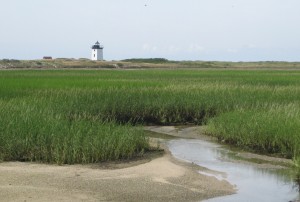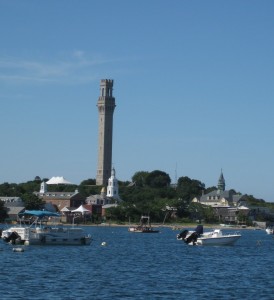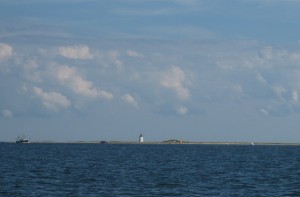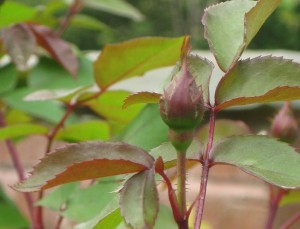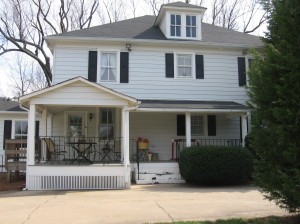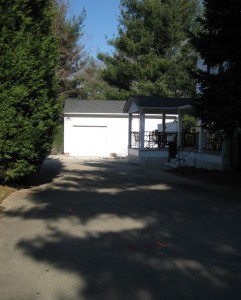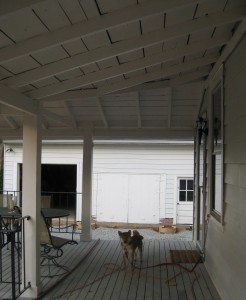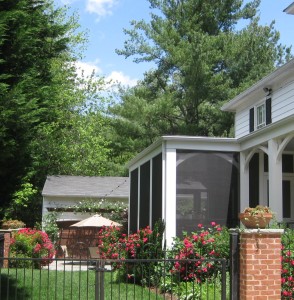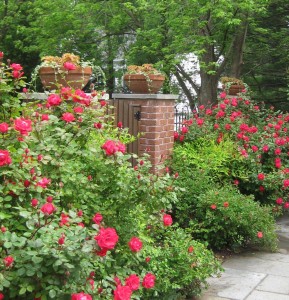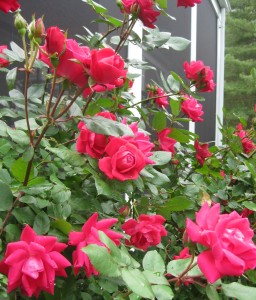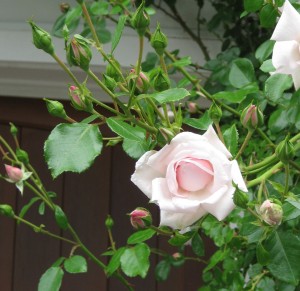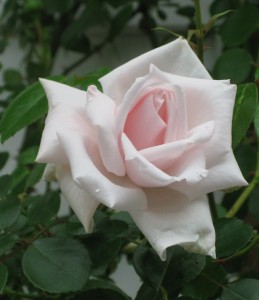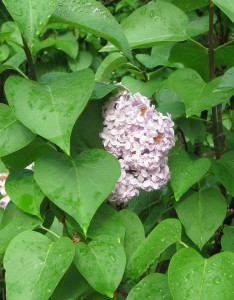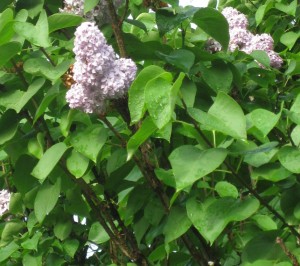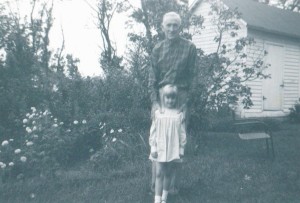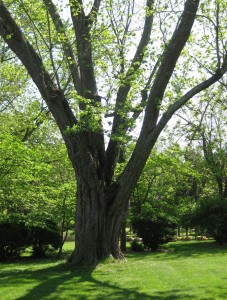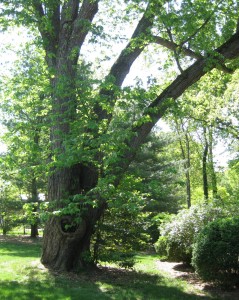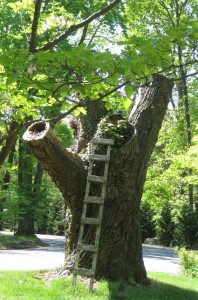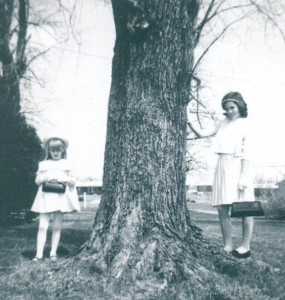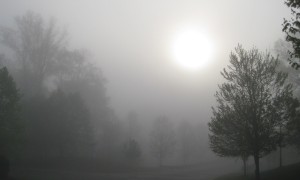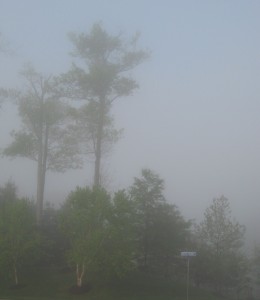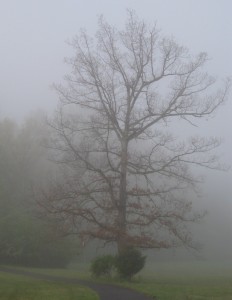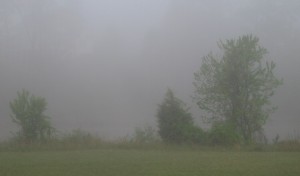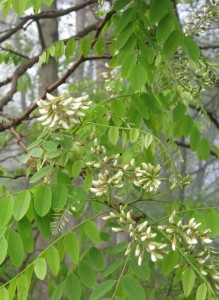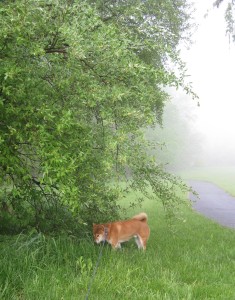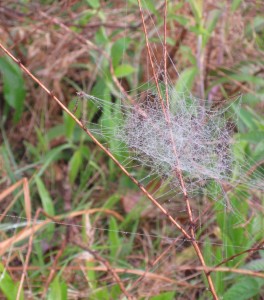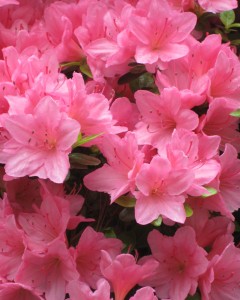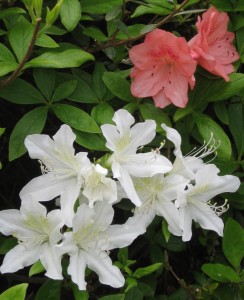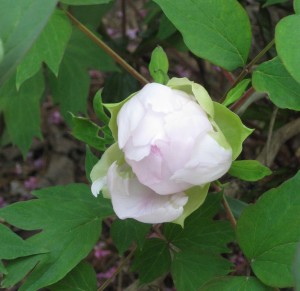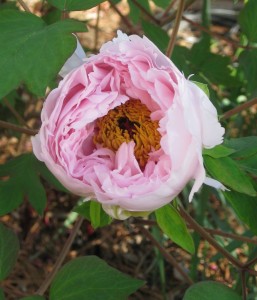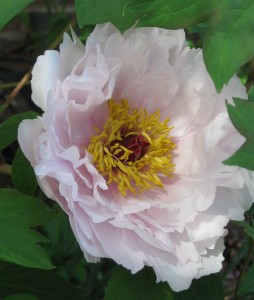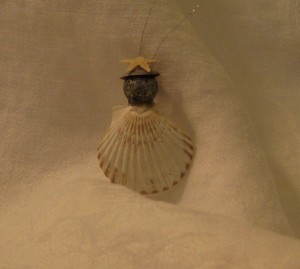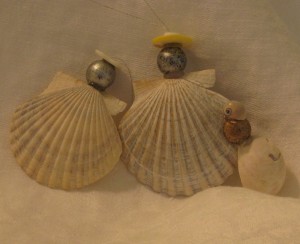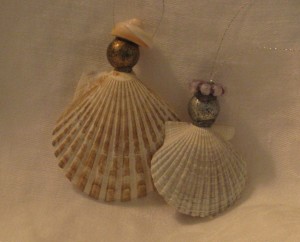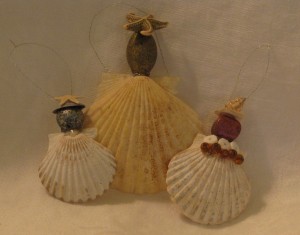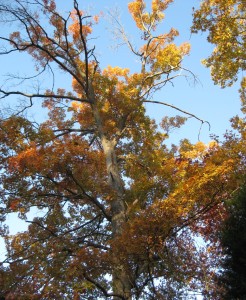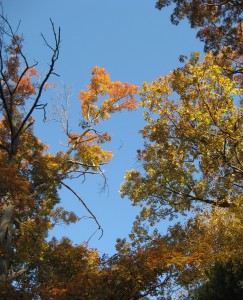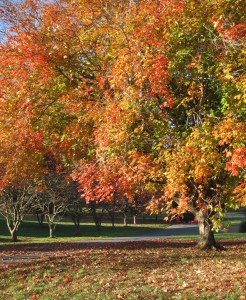Category Archives: Nature
Up from the Concrete, Roses
Our back yard, when we first moved into our house, was not really a yard at all. It was a rather dismal expanse of cracked concrete. The previous owner was the developer who built the neighborhood in the 1970s. He used the large detached garage to store heavy machinery. There was a small back porch, to which a wooden wheelchair ramp had been added during the last years of the owner’s life. The only greenery was an enormous blue spruce that hid the oil tank and sheltered many bird families.
To my husband, the back of the house and its surrounding concrete pad resembled an old gas station. From the very beginning, he saw it as something that cried out for major changes. I wasn’t as harsh a judge. While the area wasn’t pretty, certainly, I saw a convenient play area for our daughter, a place for hopscotch and exuberant chalk drawings. I envisioned it busy with various toddler vehicles, followed later by a tricycle and a bicycle.
The ramp was ugly, but it served an immediate purpose. Our daughter fought sleep with great vehemence, but motion made her sleepy. She often nodded off in the big Graaco stroller if I walked long enough. When I pushed her very carefully up the incline, she might continue sleeping. I could park her on the porch while I sat at the outdoor table and snacked or read.
Our concrete yard also functioned well for several years. It was a busy highway for a variety of wheeled contraptions, an ideal spot for the wading pool. We bounced basketballs and hit tennis balls off the garage. Chalk masterpieces were created and washed away by the rain. And then one day, we no longer needed all that pavement. We began to imagine what the space could be. We had a very blank slate.
The back of the house, before the re-do.
Lots of concrete.
Unfettered by training wheels, our daughter exults. She put many miles on her first little bike without leaving the back yard.
It took us at least two more years of debate and procrastination before we began our big back yard project. There followed months of demolition, construction and innumerable, inevitable delays. Afterwards, we were left with a roomy sceened porch, flagstone courtyard, and a more attractive garage. There is a little grassy area for Kiko. An old-fashioned wrought-iron fence encloses it all. Unlike the front yard, which is heavily shaded by the big silver maples, the back is an oasis of bright sunlight. Where the concrete once baked white-hot, we now have a profusion of flowering plants. The red double knock-out roses quickly formed a dense hedge along the fence, and the pale pink climbing roses heartily embraced the garage trellis. From May to September, we are surrounded by a riot of roses and other flowers. For those who came by a lovely back yard easily, this might be no big deal. As for us, we still find it hard to believe that all that concrete gave way to such life and beauty.
The re-do begins, and things look worse before they began to look better. Kiko doesn’t care, though.
Our back yard and new porch, after the re-do.
Double knock-out roses along the fence.
More knock-outs by the screened porch.
Pale pink roses climb the trellis on the garage.
Just one of many perfect roses, within easy reach.
Lilacs, Lyric Hall, and June Bliss
In the early spring of the first year we spent in our house, I noticed green buds emerging from the gray branches of the tall shrub by the front walk. I had wondered about the identity of this large and leggy plant. When I looked closely, I saw the beginnings of lilac leaves. Our new old house was blessed not only by eminent silver maples, but also by a mature, substantial lilac bush. This realization brought me a jolt of happiness more typically associated with an unexpected gift, such as one that arrives in a pale blue Tiffany box. Lilacs have a special place in my heart. Like the maples, they speak of home and loved ones.
Lilacs grew in great abundance around my grandparents’ house, the locus of my earliest and happiest childhood memories. Lilacs surrounded the area in front of the smokehouse and adjacent to the chicken lot. They created a leafy enchanted shelter, a cozy enclave where I liked to play with my grandmother’s kittens.
Atlanta is generally too hot for lilacs. I missed them, growing up in Georgia. For me, the lilac became a symbol of a time long past, alive only in memory and never to be repeated. I didn’t expect to live among lilacs again.
Then I moved to New Jersey, where lilacs, like peonies, thrive. My walks into Rocky Hill took me past a ramshackle former church in the center of town. Built in 1870 as a Methodist Episcopal church, by the early 20th century the building was known as Lyric Hall and used as a community theatre and concert space. I knew the place as the home of a dear friend with the unlikely, romance-novel-worthy name of June Bliss. For many years, June was the warm and capable administrator at the center of the art history department at Princeton University. To anxious grad students she was a calm and motherly presence. To professors preoccupied with the esoteric details of research, she was a grounding force.
Lyric Hall became June’s home in the early 1970s. She rented out the old sanctuary as a warehouse and lived in a warren-like apartment that had been added to the back of the building in the 1940s. June’s girlhood home was a magnificent Gothic revival house near Princeton, where her sister continued to reside. It baffled me that after growing up in such an architectural gem, she was content with her quirky, cramped apartment. I always imagined how the church could be renovated into a striking, spacious, light-filled home. June probably could have easily afforded such a project, but she wasn’t interested. She was thoroughly without pretense, and her unusual living quarters suited her just fine. I think she enjoyed the surprise in the eyes of first-time visitors’ to her decidedly eccentric home.
The old church was set on an expansive piece of property that adjoined what had once been the town green. June had a large garden in the side yard, bounded by a towering hedge of lilacs. She was generous with her bounty of vegetables and flowers. She encouraged me to cut as many lilacs as I wished, which I gladly did, usually under the watchful eye of the neighbor’s hulking pot-bellied pig. Every spring, thanks to June, our apartment was filled with bouquets of lilacs, in addition to the peonies I bought down the road. On a return visit after H and I had married and moved south, June dug up forget-me-nots from her garden to send back with us. I planted them behind our townhouse, where they are probably blooming still.
June was a cheerful person with a lively sense of humor and a keen appreciation for irony. She retained her sunny disposition in the face of the cancer that afflicted her for a number of years before finally claiming her life. I remember very clearly the warm summer day I went to the mailbox and found the kind note from June’s daughter that broke the news of her mother’s death. D was very young at the time, and we had been playing in the yard together. Seeing my sudden tears, she dashed over to comfort me. Our lilac bush serves as a reminder that departed friends, as well as the essence of home and family, remain with us always.
This spring, though, I was dismayed that only one small lilac bloom appeared. For several years now, blossoms have emerged only at the very top-most branches. June’s vigorous lilac hedge, in contrast, bloomed profusely, from bottom to top, for decades. When I asked if she had a gardener’s secret, she laughed and replied that she simply appreciated the plants and left them alone. Our lilac evidently needs something more than admiration. I’ve read that an aggressive pruning can reinvigorate an old lilac plant. We will get the shears out this weekend and go to work.
I recently discovered that upon June’s death, her home was donated to the New Jersey Historic Trust. The Trust sold it, with a preservation easement, to an architectural firm that restored the building to its original appearance and now uses it as their headquarters. The gray asbestos siding was removed, the original white clapboard restored and repainted. The arched windows were elongated to their full height and the sanctuary space’s soaring ceilings were restored. June’s old apartment was replaced with a bright and much larger one.
It’s remarkable to me that even though June didn’t care to restore Lyric Hall for use as her own home, she made it possible that others, later, could enjoy the beauty of the renewed historic building. It gives me hope for the rehabilitation of our tired lilac bush. Lyric Hall flourishes again, a fitting memorial to its former owner, and I’m convinced our lilacs can, too.
The Silver Maples Say Welcome Home
For the past two weeks or so, the seed pods have been falling from the big maple trees in our front yard. As the wind blows, they hit the roof with a sound like a shower of fat raindrops or forcibly hurled pea gravel. The tiny twirling helicopter blades drift slowly to the ground. Our daughter used to love to chase the flying seed pods. They gave my husband and me a welcome break from hands-on parenting. On warm weekend afternoons, we’d sit in cheap aluminum lawn chairs and watch her zigzag happily across the grass. We all still appreciate those spinning seed pods, despite the legion of tough little seedlings that spring up among the flower beds. We certainly love the trees that send them forth.
It was in the late fall, nearly eleven years ago, when we first saw our house. Most homes in our area date from the seventies through the nineties, and it stood out because of its age. Built in 1920, it was originally the center of a two-hundred acre farm. Unlike most northern Virginians, who apparently put a high value on new construction, I actively wanted an old house. I like the idea of a house with a past, with character, with some history behind it. Having watched my grandparents’ lovely old Victorian slip through our fingers, as well as the demolition of my grandmother’s birthplace, a far more historic dwelling, I wanted the chance to be a good steward of someone else’s family home.
I had all but lost hope of finding a livable old house, but suddenly we had stumbled upon one. It was a little shabby, and it had aluminum siding. But it was a genuine old farmhouse, a classic American four-square, with sizable rooms and a sensible floor plan. While it contained some dated 1970s touches, such as expanses of orange shag carpeting, it was solid and didn’t appear to need structural renovation.
And it had those wonderful trees, a semicircle of six huge trees that shaded the front yard. They were silver maples just like those that twisted their knobby roots through the soft grass at my grandparents’ house in Kentucky. Because it was late November, the branches were bare, but the shaggy gray-brown bark was as recognizable as the face of an old friend. This was the house! I was certain of it. The silver maples offered living proof.
Because my husband is a clear-headed man of business and science, he weighed all conditions carefully and made a low-ball offer on the house. I was anxious, nearly certain we wouldn’t get it, already formulating back-up plans. Maybe that 1980s house (the one annoyingly referred to as an “executive colonial”) wasn’t so bad after all. Or we could give up the search and spend another year in our rented townhouse. But our daughter, a new walker, needed more space and a yard in which to roam. I wanted an old house. I wanted the old house with the old maple trees. The one that just seemed like home.
Luckily, the prevailing local bias against older homes worked to our advantage. We managed to learn that our only serious competition was a developer whose goal was to tear down the house and build a bigger, newer one. Better yet, two. The owner, fortunately for us, much preferred that the house in which she had raised her children continue to be a family home.
During the following December, matters concerning our purchase took off on a wild roller coaster ride. There were complications with the contract, concerns about the foundation, the floors, the septic system, the furnace, the roof, the crazy property lines, and more. During our Christmas vacation with H’s family in Rochester, he was on the phone constantly with building inspectors and legal experts. But by early January, the house was ours. Our realtor, who had decades of experience, claimed that the closing was the most dizzyingly complex one she had ever witnessed.
That winter, while H worked especially late, I often sat by an upstairs window in a rocking chair, holding our year-old daughter. As she nursed, or slept, smiled or cried, I looked out through the somewhat uneven glass at the dark blue shadows the big maples cast on the snow-covered ground. It sure was good to be home. And it still is.
Silver maples are fast-growing trees with limited life spans.
We had to remove this tree’s branches when they became fragile
and hazardous to passing cars, but we left the trunk as a monument. Our daughter occasionally uses it as a place of solitary refuge.
On an Easter Sunday in the 1960s, my friend Jeanie and me
beside one of the silver maples in my grandparents’ yard.
Foggy Morning
We woke up to a morning fog that reduced the spring colors
to black, white and shades of silver-gray.
A bit later, green and blue tones begin to emerge.
The street sign, appropriately, reads Misty Pond.
This oak is evidently in no hurry to welcome spring.
I can see the painter George Inness capturing this scene.
A locust tree beginning to flower.
The dampness seems to heighten all the attractive smells.
Kiko had much to attend to this morning.
The scrubby foliage by the pond was dotted with dew-covered spider webs.
A lone mallard on the pond.
April Flowers: Azaleas
April Flowers: Tree Peonies
Peonies like a good cold winter, so they are rarely seen in Georgia. I first became acquainted with them when I lived in New Jersey, which apparently offers the perfect climate for the flower. As a house-sitting grad student, I brought in armfuls of peonies from the back garden and was then surprised to see the dining room crawling with ants. I learned to check for ants hiding in the profusion of petals.
After my husband and I were first married, we lived in an apartment on the outskirts of Princeton. Once the snow melted, I often walked the pleasant country road that led into the tiny, picturesque town of Rocky Hill. In front of one old farmhouse along the way sat a big stoneware urn filled in spring and summer with cut flowers for sale on the honor system. There was a hand-lettered sign and a battered metal box for the cash. The peonies were especially beautiful and bountiful, and our apartment was well supplied with the dramatic flowers. I loved living in a place where such trust was still possible. The peonies we now grow around our house in Virginia will always remind me of my rambling walks in sweet old Rocky Hill.
Our first tree peony bud of the season.
The same bud, now opening, two days later.
The full-blown blossom, lush and ornate.
Cape Cod Shell Angels
My husband’s family has vacationed in Cape Cod since he was a little boy. They cherish their time on the Cape. It’s a Family Tradition marked by capital letters and exclamation points. They will battle illness and adversity to reach the Cape. Fortunately, I appreciate the unique environment as much as they do. We began taking our daughter there when she was two. Her love of the Cape was immediate, as natural to her as breathing. H’s parents were immensely pleased with the discerning wisdom of their young granddaughter.
Our quaint little rental cottages look out across the bay to the Pilgrim Monument in Provincetown and the lighthouse at the tip of the Cape. We feel privileged to spend time each summer in this transitional, luminous, glorious spot. As in such magical places as Cornwall, Mont St. Michel and Key West, the expected balance of land and water has shifted. The land resembles a narrow ribbon drifting on the water. The sky is vast. The light is awe-inspiring, ever-changing.
The land itself is in constant flux. I was unprepared for the quiet drama of the bay. Growing up, my beach experiences were limited to the Gulf of Mexico and the Atlantic coasts of Georgia’s islands. Both are beautiful areas, but they lack the sharply defined tidal contrasts of Cape Cod Bay. Every year without fail, soon after we arrive, a knock at our screen door signals Grandpa’s delivery of our copies of the tide chart, our guide to daily life. At low tide, the flats extend nearly as far as the eye can see. The shallows glimmer like silver in the shifting sunlight. When the tide begins to rush in, the change is at first almost imperceptible. Before long, though, the water is swirling around us, its determined, unstoppable force clearly evident. At least once every day, we watch as the expanses of sand shrink into islands, smaller and smaller, before they become completely submerged again.
The bay is not a prime beach for shelling, but occasionally it offers up its particular treasures. Every so often, during an especially low tide, scallop shells dot the flats like pale, muted jewels, their colors subtle and austere. Naturally, my daughter and I collect them. Over the years we had acquired several sand pails full before we discovered an ideal, simple way to transform the shells into appropriate mementos. With the addition of a few beads and smaller shells, they became Christmas angels. (Once again, the hot glue gun allowed us to turn out a host of ornaments quickly and easily.)
Our little angels keep Cape Cod with us during the off-season. The medieval pilgrimage connotations of the scallop shell give the angels a certain dignity and make them all the more evocative. One of the world’s first souvenirs, the scallop shell became the emblem of the pilgrimage to St. James of Compostela, the several routes of which stretch through the mountains of France to northern Spain. Tourism on a grand scale was born in these pilgrimage routes, and the Way of St. James continues to attract pilgrims, many still on foot. Medieval pilgrims were, to some degree, tourists, just as many of today’s tourists are, in a sense, pilgrims. For travelers of the eleventh or the twenty-first century, whether navigating the perils of wilderness paths or the trials of Interstate 95, the goals of the journey are similar and elemental: an escape from the daily routine, the promise of adventure, a firmer grasp of life’s real meaning, and the opportunity for spiritual renewal. I love it that such richness of meaning is tied up neatly in the humble shell angels on our Christmas tree. *
*One final, fitting point of interest: our scallop shells wash ashore near the place where our country’s first pilgrims landed. As most of us learned and later forgot, the Mayflower’s initial stop in the new world was in what is now Provincetown Harbour.
Once Again, Morning Light
How good it is to walk in the morning sun again! Last week when we were still plodding along blindly in the dark, Kiko paused and I didn’t notice (couldn’t see him, never think I really need a flashlight). My shin hit his rock-hard head. The blow didn’t phase him, but I found it painful enough to wonder momentarily if I had fractured my leg. Now that we’ve Fallen Back and said goodbye to Daylight Savings Time, it’s great to see where I’m going again. The fall colors are especially brilliant here in Virginia, and we savor them all the more after the devastating rains of this past September.
Local color.
A bright November morning in Virginia.

